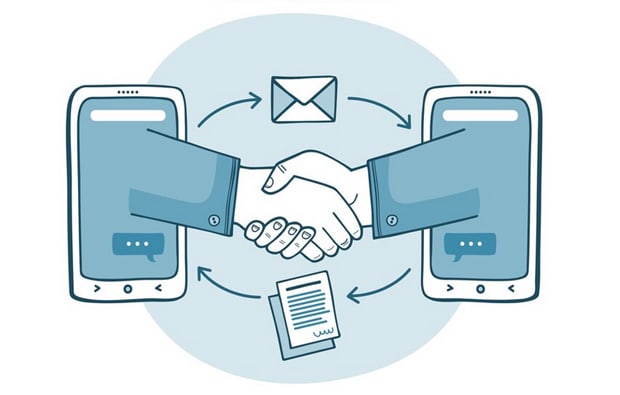
B2B Integration Software: Businesses usually share information with customers, partners, and vendors. B2B integration software simplifies this process. It helps companies automate tasks and protect their data. This article will discuss the various types of integration software and explain why it is essential for businesses. We’ll also look at the critical features to consider when choosing software for your business. Now, we will give you tips on how to maximize your integration software solution and boost your business.
What Is B2B Integration Software?
B2B software helps companies with many essential tasks. It links apps and data from various networks, enabling customers to make fast purchases. This technology allows businesses to automate invoice sending and customer account management. Data is transferred from one system to another, allowing the receiving network to understand it securely.
Why is B2B integration software essential?
B2B integration software is helpful for businesses. It makes it simple to interact, exchange information, and handle orders promptly and securely. B2B integration software saves time and money for businesses and boosts revenue. This software helps companies easily connect with their trading partners and ensures data protection. B2B integration solutions can be beneficial for your business.
What are the Types of B2B Integration?
Staying connected and updated is crucial for business success. B2B integration allows computer systems and apps to connect and share information. B2B integrations come in various types, each with its unique way of functioning. Integration platforms can improve system efficiency and enable faster decision-making. Understanding different types of B2B integrations can assist in choosing the most suitable option for your business.
1. Data Integration
Data integration involves combining data from different sources into one database or file. It helps businesses comprehensively understand their customers, products, and operations. You can do it in different ways.
- Managed File Transfer Protocol (MFTP)
- Web Services
- Extract-Transform-Load (ETL) tools
Data integration makes collecting and merging data from various systems, databases, or sources easier. It means you can see different perspectives simultaneously, which helps you make better decisions. Moreover, it saves time, cuts costs, and enhances customer satisfaction.
2. System Integration
This type includes various systems or subsystems and their hardware components. System integration involves combining computer systems with software applications and data from databases. The purpose is to make them work together as one system and complete business tasks efficiently. Using the latest technologies, communication between people has become much more manageable. Additionally, it simplifies extracting and sharing data across different systems. It makes things easier by linking other parts of a business together in one system.
3. Process Integration
Do you want to boost your business in today’s world? Consider process integration as a viable option. It combines system integrations and business process automation. Additionally, it allows your business to establish connections with other companies and exchange vital information to improve efficiency and foster growth.
Process integration simplifies work by automating manual tasks, streamlining workflows, and connecting different systems. This model helps you get what you need without any loose ends. Automating processes helps businesses work efficiently and save money.
4. Application Integration
Businesses and trading partners use systems like CRM or ERP, which can be hosted on-premise or as cloud apps, to meet their business needs. There are two ways to achieve application integration:
1. Using Data Integration
You can learn about application and data integrations to understand how applications communicate. You can share information, send files, and receive responses. Application integration simplifies this process.
2. Combining Various Business Applications into a Single Platform
Companies can use unique technologies to link different applications. By doing this, they can combine all the apps into one app with a consistent interface. They can also connect two applications and collect user-entered data on a website.
Integrated apps can improve your understanding of crucial information, which will help your business generate profits. Application integration allows you to use various data formats and tools to monitor and ensure accurate operations within your company.
5. Cross-Company Integration
Companies can improve collaboration by implementing cross-company integration. It helps them combine resources for faster results and access the latest information. An API is like a bridge connecting companies, helping them share information quickly and make the most of what they offer. It helps businesses learn from each other and stay ahead of the competition.
Key Features of B2B Integration Software
When choosing integration software, it’s important to consider critical features. Knowing these features will help you choose the best option for your business. Here are some essential components of integration software:
1. Application Integration
When searching for B2B software, ensure it integrates with different apps. A B2B solution must connect with multiple business applications. Today, businesses use applications such as NetSuite, SAP, and Salesforce. By combining them into one system, you can automate your business processes.
This step improves the speed and security of connecting apps from different domains. Enterprises require access to various systems, making integration essential. This process helps transfer data in real time between applications across other parts of the operating system. It optimally manages transport protocols for server migration and system growth.
2. Mapping and translation
Businesses often need to convert information from one format to another. Integration software can assist with this task. It helps users see data fields and document relationships visually. Businesses can easily translate or map out the data they need for their jobs using mapping and translation tools. Mapping and translation help people do their jobs more efficiently by ensuring consistency, accuracy, and speed. Integration software is essential in today’s digital world.
3. Analytics and insights
Analytics and insights help organizations make better business decisions by providing valuable intelligence. These provide companies with insight into how their systems interact with others. These also help them find areas to improve and be more efficient. Using an effective analytics dashboard can help B2B integration gain a competitive edge.
4. Tracking and reporting messages
This great feature keeps you, your administrators, and your trading partners updated in real time. You can track and report messages easily with a centralized dashboard. You can easily communicate with your connected people using this feature.
5. Communications Adapters
Using communication adapters in an integration solution can improve the security of internet connections. Communication adapters help computers communicate effectively, enabling businesses to work faster and more accurately. Additionally, these tools aid in saving money and guarantee access to the latest information at all times.
B2B Integration Software Challenges and How To Overcome Them
Integration software is an excellent way for companies to make their operations more efficient. However, as integrated software becomes more popular, it also brings its own set of challenges. B2B integration can be challenging, but there are ways to overcome these difficulties.
1. Data Control
Managing data is a major obstacle in B2B integration. You can transfer data between connected systems using a controlled process. Additionally, companies should implement robust measures to maintain data integrity with their business partners. It includes thorough testing, protecting sensitive information with encryption, and regularly monitoring it.
2. Trading Partner Onboarding
To set up a B2B connection, you need to ensure that all your business apps and systems can communicate. You might have to collaborate with various companies, such as suppliers or customers. With the right cloud software, you can connect all of them in one place. Data is exchanged quickly and securely without any issues.
3. Data Discrepancy
Data discrepancies can be a problem when linking two computer systems. To find these, companies need to track their data and regularly check for any issues. It’s essential to quickly determine the cause and take action when a discrepancy is found. Machine learning tools can speed up problem detection. By addressing issues promptly, businesses can prevent them from escalating and avoid financial losses. Companies can reduce the chances of data discrepancies by using appropriate methods and technologies.
4. Limited Tools and Resources
The right tools and resources are crucial for completing tasks quickly and efficiently without unnecessary delays or expenses. Before starting a project, make sure you have everything you need. It includes data transfer programs, secure storage solutions, and comprehensive testing methods. These tips will make your projects run smoothly and give you peace of mind.
5. Data Security
Security is essential when using cloud based services. Conduct a security evaluation to check if the vendor meets your requirements and has safety policies in place. Companies need to protect their information from hackers constantly trying to gain unauthorized access to systems. A good integration software should have strong security measures like authentication protocols and encryption layers to protect data while it is being transferred between networks. Companies can enhance their security using two-factor authentication and data leakage protection tools.
How B2B Integration Software Benefits Businesses
B2B software makes tasks more manageable, improves team collaboration, and provides real-time data access. Here are the benefits businesses can enjoy:
1. Cost Savings
Have you ever been to a store and had to wait in line to pay? That’s all part of the supply chain. Businesses allocate around 3% of their total revenue to supply chain activities. These activities include managing inventory, business processes, order processing, shipping, customer service, and invoicing.
B2B software improves business processes for better accessibility and efficiency. It connects and automates data flow between different business systems. B2B software helps companies be more productive, make fewer mistakes, and use fewer resources.
2. Increased Efficiency
Managing delivery, invoices, and orders can be challenging for businesses. B2B software can improve their performance. It helps companies by providing access to essential data like shipping documents, invoices, purchase orders, and bills of lading. It saves businesses time and makes them more efficient. B2B software helps minimize errors in task execution.
3. Improved Data Quality
Companies use various methods to manage data. It means that when they have to give or receive data from a business partner, they often lose or copy it incorrectly. B2B software makes the process easier and more efficient by automating data transfer and ensuring everyone has the same data version. By providing everyone with accurate information, it saves time and avoids the need for double-checking. Business-to-business integration software centralizes data storage, making it easily accessible for everyone.
4. Enhanced Control and Visibility
To be ready for challenges, understand how your business operates. B2B integration software is a tool that connects your company’s systems with those of your suppliers and partners, making things easier. Having access to real-time information lets you stay updated on what’s happening in your supply chain and make prompt changes when necessary.
What Is the Future of B2B Integration?
B2B integration’s future is promising as more businesses seek its advantages. Companies use cloud services and software to make their operational processes more efficient. Technology is constantly advancing, so businesses can look forward to new features that will make things smoother and more secure. Additionally, you’ll have access to more advanced analytics, insights, and secure communication protocols.
B2B integration software improves efficiency and provides real-time data for businesses. Companies can use software integration services to automate manual tasks and make workflow processes more efficient. It allows them to easily share critical business data with other companies and build a stronger network.
Final Words
B2B integration software can be complex and powerful to manage. This guide gives you a quick look at different types of software and how they can help you improve essential business processes. To make an informed decision, it’s important to understand these things.
You can enhance efficiency, cut costs, and stimulate business growth with the right business integration services. Before making your choice, think about the features and benefits of each solution. To ensure your business succeeds, use comprehensive and well-planned integration software.



